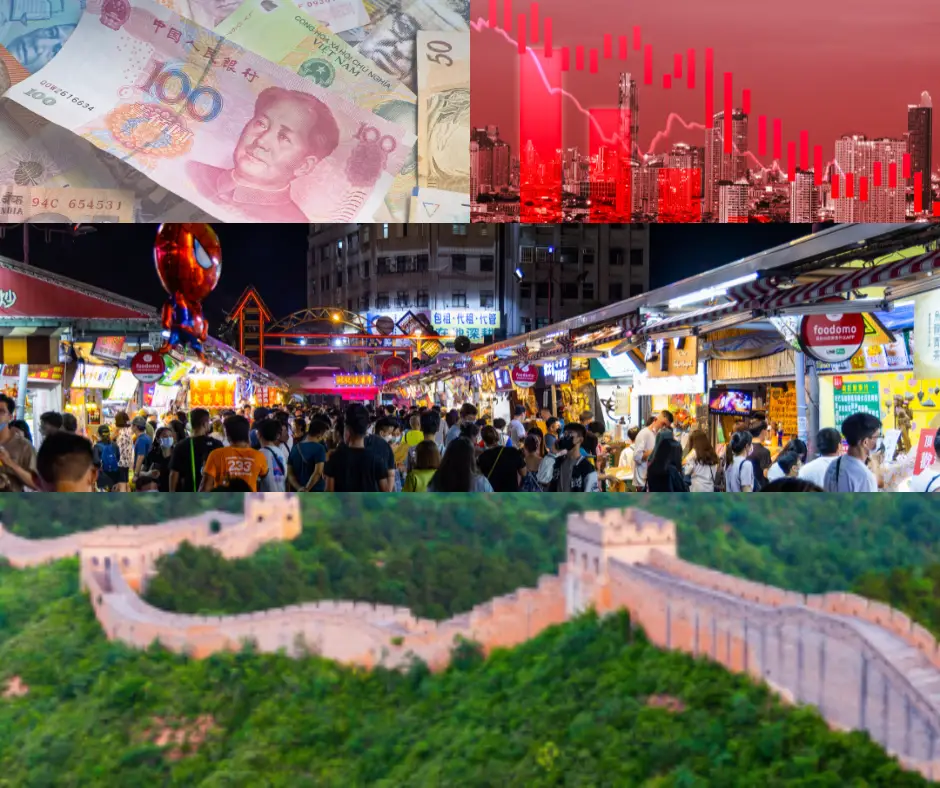Introduction
As the world changes, so does the Chinese economy, which is a significant player in the global economy. Understanding the complex dynamics of China’s economy, its current state, and the challenges it faces is essential. China’s economy impacts all strata of society, from bustling cities to rural areas. In this overview, we aim to provide a comprehensive understanding of China’s economic journey with a human touch.
Table of Contents
Chinese Economy: A Tale of Growth
China’s economic growth has been unparalleled, propelling it to become the world’s second-largest economy. Ambitious reforms, rapid industrialization, and strategic investments have fueled this growth, impacting all aspects of society. From the emergence of manufacturing hubs to the exponential growth of e-commerce, China’s economic journey is a tale of remarkable growth and global significance.
However, with significant growth come great challenges. Like any other economy, the Chinese economy is not immune to fluctuations and hurdles. Amidst the glitz and glamour of skyscrapers and bustling markets lie underlying challenges that demand attention and resolution.
Challenges on the Horizon:
1. Debt Burden:
The Chinese economy faces a mounting debt burden, raising concerns about the sustainability of its economic model. The corporate and local government-level ballooning debt poses systemic risks and could undermine long-term growth prospects.
According to data from the Bank for International Settlements (BIS), China’s total debt-to-GDP ratio was around 282% in 2023, which indicates a significant debt burden. Corporate debt, especially among state-owned enterprises (SOEs), is still high, posing risks to financial stability and potential spillover effects on the global economy. The Chinese government has addressed the debt issue, including deleveraging efforts and tightening regulations on shadow banking activities.
2. Demographic Shifts:
Another significant challenge is demographic shifts, characterized by an aging population and a shrinking workforce. China’s one-child policy, which was in place for decades, has led to an aging population pyramid, posing challenges for pension systems, healthcare, and overall productivity. Addressing these demographic challenges requires innovative policies and investments in healthcare, education, and social welfare.
- According to National Bureau of Statistics (NBS) data, China’s working-age population (aged 15-64) has declined since 2014.
- The proportion of elderly citizens (aged 65 and above) has been steadily increasing, posing challenges for pension systems, healthcare services, and labor productivity.
- To mitigate the impact of demographic shifts, China has relaxed its one-child policy, incentivized childbirth, and implemented policies to encourage elderly care and workforce participation among women and seniors.
3. Technological Innovation and Competition:
China must navigate the complexities of innovation and competition in an era of rapid technological advancement. While the country has made significant strides in artificial intelligence and renewable energy, it faces stiff competition from global peers. To maintain its edge, it must continue to invest in research and development.
- China has emerged as a global leader in technology, with significant investments in artificial intelligence (AI), 5G, biotechnology, and renewable energy.
- Despite technological advancements, China faces challenges such as protecting intellectual property rights (IPR), overcoming market access barriers in foreign countries, and overcoming geopolitical tensions that affect international collaborations and technology transfers.
- The Chinese government has rolled out initiatives like “Made in China 2025” and “Internet Plus” to promote indigenous innovation and upgrade traditional industries through digital transformation.
4. Environmental Sustainability:
The pursuit of economic growth has damaged China’s environment, leading to air and water pollution, deforestation, and habitat destruction. Environmental sustainability has emerged as a pressing concern, with calls for stricter regulations, investments in clean energy, and efforts to transition towards a greener economy.
- In numerous urban areas across China, PM2.5 levels surpass the WHO guidelines, which indicates that air pollution is still a significant problem in Chinese cities.
- China, the most significant greenhouse gas emitter, is now a global leader in renewable energy adoption, with ambitious targets for expanding solar, wind, and hydroelectric power.
- The government has implemented carbon pricing, emissions trading schemes, and stringent environmental regulations to reduce pollution and encourage sustainable development.
5. Income Inequality and Social Cohesion:
China grapples with widening income inequality and disparities between urban and rural regions. Bridging this gap is crucial for promoting social cohesion and ensuring sustainable growth that benefits all segments of society.
The National Bureau of Statistics (NBS) reported that China’s Gini coefficient has increased to 0.469 in 2022, indicating a rise in income inequality. There are disparities between socioeconomic groups, urban and rural areas, as well as coastal and inland regions. In order to tackle income inequality, China has implemented measures such as targeted poverty alleviation, minimum wage hikes, and social security reforms to provide a safety net for vulnerable populations.
Navigating the Way Forward:
China’s current economic landscape presents challenges like income inequality and urban-rural disparities. However, there is optimism as individuals throughout the country spearhead innovative solutions and push for change at the grassroots level.
1. Structural Reforms:
Structural Reforms: China must implement significant structural reforms to foster sustainable growth and tackle the issue of debt. These reforms should focus on reducing financial leverage, enhancing corporate governance, and improving the efficiency of state-owned enterprises.
To overcome the challenges of income inequality and urban-rural disparities, China must implement structural reforms that address these issues head-on. This includes measures to promote equal distribution of wealth and resources, improve access to quality education and healthcare, and develop sustainable infrastructure in rural areas. Additionally, efforts should be made to foster entrepreneurship and innovation, creating opportunities for economic growth and job creation across all regions of the country. Ultimately, by prioritizing these reforms and empowering individuals at the grassroots level, China can navigate toward a more inclusive and prosperous future.
2. Investing in Human Capital:
China recognizes the significance of human capital in driving innovation and productivity. Hence, it is increasing its education, healthcare, and vocational training investments. By providing its workforce with the necessary skills and knowledge required for future jobs, China aims to maintain its leadership in the global talent competition.
3. Green Transition:
As part of its efforts to promote sustainable development, China is making a concerted effort to turn towards renewable energy sources and implement eco-friendly policies. The country recognizes the importance of reducing carbon emissions and conserving natural resources and is taking significant steps to make this a reality. By transitioning towards cleaner energy sources, China is proactively mitigating climate change while ensuring a better future for its citizens and the global community.
4. Harnessing Technology:
China is actively fostering innovation and entrepreneurship across various sectors, with a strong emphasis on leveraging the power of technology. In recent years, the country has witnessed a tremendous transformation in its economy, thanks to the advancements in the tech industry. One of the significant areas where technology has played a pivotal role is finance, where fintech has revolutionized financial services. From mobile payments to digital banking, the Chinese financial sector has witnessed a significant shift, with more and more people embracing the convenience of digital finance.
Similarly, agriculture is another sector that has undergone a significant transformation through technology. With agritech, farmers can now leverage precision agriculture, crop management, and smart irrigation to increase yields, reduce costs, and minimize environmental impact. Overall, technology is driving change and growth in the Chinese economy, and the country is poised to continue leading the way in innovation and tech entrepreneurship.
5. Promoting inclusive growth:
Promoting inclusive growth is crucial for China’s pursuit of high-quality development. It is essential to ensure that the benefits of growth are shared equally among all members of society. To achieve this goal, targeted policies should address income inequality, bridge the gap between urban and rural areas, and promote social mobility.
Conclusion:
As we consider the current state of the Chinese economy and its challenges, it is clear that the road ahead is complex and uncertain. However, amidst these challenges, there are opportunities for growth, innovation, and transformation. By embracing change, building resilience, and nurturing the entrepreneurial spirit that characterizes the Chinese people, China can navigate its way toward a brighter and more prosperous future. As observers and participants in this journey, let us offer our support and solidarity to China as it navigates through the winds of change and shapes tomorrow’s economic landscape.







